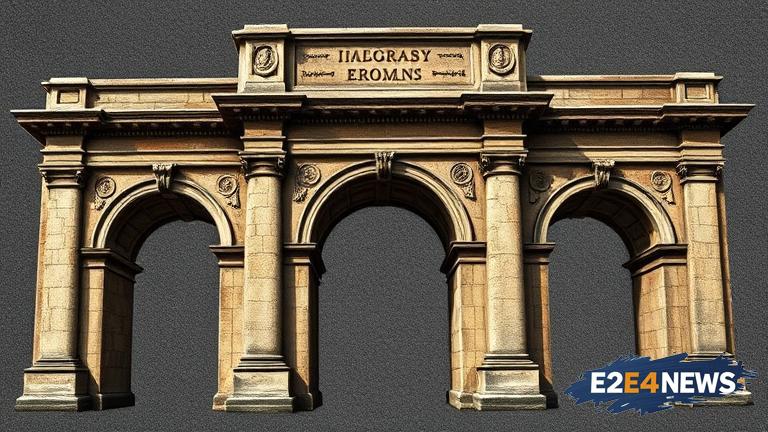The use of triumphal arches on Roman imperial coins is a fascinating aspect of ancient numismatics. These arches, which were originally built to commemorate significant military victories, became a staple of Roman architecture and were often featured on coins to symbolize the power and prestige of the Roman Empire. The first triumphal arches were built during the Roman Republic, but it was during the Roman Empire that they became a ubiquitous feature of the landscape. Emperors would often commission the construction of these arches to celebrate their military conquests and to solidify their legacy. The arches were typically decorated with intricate carvings and sculptures, which were meant to convey the message of Roman dominance and superiority. On coins, the depiction of triumphal arches served as a visual shorthand for the emperor’s military prowess and his ability to bring glory and prosperity to the empire. The most famous example of a triumphal arch on a Roman coin is probably the Arch of Titus, which was built to commemorate the conquest of Jerusalem in 70 CE. This arch was featured on a number of coins during the reign of Titus, including the famous Judaea Capta coinage. Other emperors, such as Trajan and Constantine, also featured triumphal arches on their coins, often in conjunction with other symbols of power and authority. The use of triumphal arches on coins was not limited to the Roman Empire, as other ancient civilizations, such as the Greeks and the Parthians, also employed similar motifs on their currency. However, the Romans were unique in their extensive use of these arches as a symbol of imperial power. The depiction of triumphal arches on coins also reflects the complex and often fraught relationship between the Roman Empire and its subject peoples. While the arches were meant to inspire awe and admiration, they also served as a reminder of the empire’s military might and its ability to impose its will on conquered territories. In addition to their symbolic significance, the triumphal arches on Roman coins also provide valuable insights into the artistic and cultural trends of the time. The level of detail and craftsmanship that went into the depiction of these arches on coins is a testament to the advanced state of Roman numismatics and the importance that was placed on coinage as a means of communication and propaganda. Overall, the use of triumphal arches on Roman imperial coins is a fascinating topic that offers a unique window into the culture, politics, and values of ancient Rome. By examining these coins and the context in which they were produced, we can gain a deeper understanding of the Roman Empire and its enduring legacy. The study of Roman coins is a rich and rewarding field that continues to captivate scholars and collectors alike, and the depiction of triumphal arches on these coins is just one of the many fascinating aspects of this subject. The triumphal arches on Roman coins are a powerful reminder of the empire’s grandeur and its ability to inspire wonder and awe in people around the world. As we continue to study and appreciate these coins, we are reminded of the importance of preserving our cultural heritage and the need to learn from the achievements and mistakes of the past.
